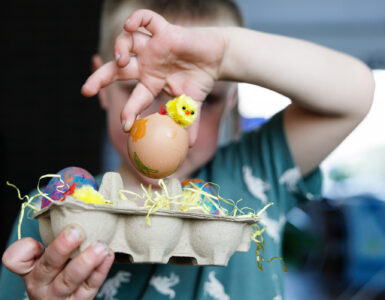Photographs can tell a story better than any word in the dictionary – if you
shoot with purpose and thought.
Photographer Veronica Reeve teaches how to let you pictures tell the story.
We’ve all seen examples of journalistic photography in magazines and
newspapers—pictures, or a series of pictures, that tell a story in images
rather than words. Photographs can capture memories, convey emotions,
and develop a narrative better than even the most descriptive words. You,
too, can learn to take pictures of your everyday life to tell a story without
saying a word. Let your pictures tell a story by applying the following tips:
Always Have Your Camera Ready To Go
Whether you are using a point and shoot, a smart phone, or a DSLR, you need
to be prepared. If you turn your back to run into the other room to grab your
camera or take the time to load a new memory card, a priceless moment or
photographic masterpiece may be lost. Did your child just spill a whole box
of cereal on the ground? Is your little girl walking around in her mom’s
heels? Take the picture BEFORE and worry about the cleanup later. The
messes can wait, but the moment will not and it will be a great photo to
laugh about later. Also remember to always have extra batteries and
memory cards on hand.
Be Discreet To Get That Candid Shot
People, and especially children, are programmed to stop what they are doing
and smile as soon as a camera comes out. If you see something you want to
document—an older child reading to their sibling or your little ballerina
practicing her dance moves—stay back, observe, and capture them before
they know you are there. These are the moments you will want etched in
your mind when your little ones have grown and a photo will help you to
cherish that moment forever! Also, keep your camera out throughout the
day, every day. If your family becomes used to you taking their picture
without having to say “cheeeese” they will be more likely to continue their
play and be natural whenever you are documenting those memorable
moments.
Shoot From Your Heart
So many times on vacation, at home with my children, or while out and about
I witness things that make me think, “I wish I had a picture of that!” These
moments are the perfect subject matter for beautiful and to-be-cherished
photographs. A grandmother snuggling her newborn grandchild, a child’s
“first”, or a father wrestling with all his children. Life is more than just a sit
and smile photo and those are certainly not going to remind you of
personalities and relationships when you look back on them 10 years from
now. Take pictures of life—the happy, sad, sick, joyous, and silly moments;
and pictures of the quirks that make someone who they are.
Compose the Shot
Photo composition is the difference between a blah photograph and a
photograph that tells a story. Compose your shot, as time allows, in such a
way that will give a clear message as to the subject and narrative of the
picture. Minimize any unnecessary distractions in the background of your
subject. One way you can minimize background distractions is by turning
your camera to “A” or “Av,” which is the aperture priority mode on your
camera. This setting gives you control of the depth of field (or how much of
the photograph is in focus) while the camera selects the shutter speed to give
you the proper exposure. A lower f/stop number in this mode will keep your
subject in focus while blurring the background. You can also reposition
yourself so that distracting elements are out of view.
In your quest to eliminate distractions, don’t forget to include people or
objects that will help to tell your story. If you are trying to photograph your
child catching his first fish while his proud father looks on, and you don’t
include the fishing pole, the fish, or the proud father, then your picture won’t
be able to convey the narrative of your photograph.
When photographing a scene always start by shooting wide, or by capturing
the whole scene first. Then move in close, taking more time to compose
your shots to capture the details/relationships/emotions of the scene. This
will give you different perspectives and allow your pictures to tell the story.
Practice, Practice, Practice
Lastly, don’t stop shooting! You will get more comfortable as you go and be
able to approach every situation prepared to produce wonderful photo-
journalistic pictures of your own.
Veronica Reeve specializes in colorful, whimsical and documentary style
photographs of babies, children and families.
To see more of her work, visit: www.veronicareeve.com
Veronica is offering a $50 print credit for Studio 5 viewers who book a
session in 2012.















Add comment